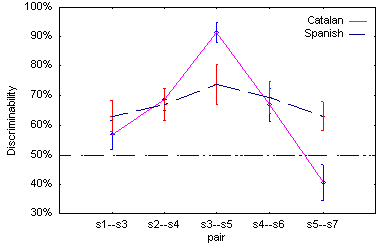
To get here, you have probably ran the demonstration of the vowel discrimination experiment. If not, please try it and come back when you are done.
The stimuli employed were seven evenly spaced vowels on a /é/-/è/ continuum. Click on the following links to listen to them again (your system must support either sun's .au format or microsoft's .wav format).
| .au: | s1 | s2 | s3 | s4 | s5 | s6 | s7 |
| .wav: | s1 | s2 | s3 | s4 | s5 | s6 | s7 |
For the "different" pairs, we used s1-s3, s2-s4, s3-s5, s4-s6 and s5-s7 (in both orders).
For each of those pairs, the percentage of correct "different" responses gives a measure of how psychologically distinct the two member stimuli are.
The "real" experiment assessed the influence of the native language of the listener on his/her perception of these contrasts. 20 Catalan speakers and 20 Spanish speakers participated in the experiment.
Spanish language uses only one /é/ vowel, which roughly corresponds to s4.au; whereas Catalan distinguishes between two types of /é/: one which sounds more like s2.au, and one which sounds more like s6.au.
Our prediction was that the discrimination should be enhanced for Catalan speakers when the two stimuli in a pair belong to the two different categories, that is roughly in the middle of the continuum. This is indeed what we observed:

Now, this is not news: it has been know for some times that the that native language influence perception of speech sounds (e.g. cf Sapir, Language, 1921).
What I did not tell you however, is that all the "Spanish" subjects were in fact highly fluent Catalan-Spanish bilinguals. Indeed, they were born in Barcelona and have been exposed extensively to Catalan since they were 4-6 years old. What our study shows is that even such an early exposure to a second language is not enough to master its sound system.
To know more about these experiments, you can send me an email and I will send back you a draft.